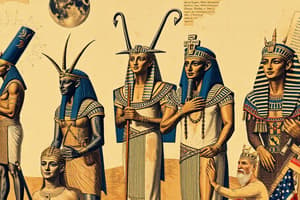Podcast
Questions and Answers
Which of the following achievements is associated with Hatshepsut?
Which of the following achievements is associated with Hatshepsut?
- Led battles against the Libyans
- Sponsored a successful trade expedition to Punt (correct)
- Restored Egypt’s religious and administrative systems
- Signed a peace treaty with the Hittites
Tutankhamun's tomb discovery was significant for understanding ancient Egyptian wealth and life.
Tutankhamun's tomb discovery was significant for understanding ancient Egyptian wealth and life.
True (A)
Who is known as the 'father of the pyramids'?
Who is known as the 'father of the pyramids'?
Sneferu
Cleopatra VII was the last active ruler of the ______ Kingdom.
Cleopatra VII was the last active ruler of the ______ Kingdom.
Match the pharaohs with their notable achievements:
Match the pharaohs with their notable achievements:
What does Ma'at represent in ancient Egyptian culture?
What does Ma'at represent in ancient Egyptian culture?
The Rosetta Stone features two writing systems: hieroglyphic and Greek.
The Rosetta Stone features two writing systems: hieroglyphic and Greek.
What was the primary function of the pyramids in ancient Egypt?
What was the primary function of the pyramids in ancient Egypt?
The god Horus is often depicted as a ______ or a man with a falcon's head.
The god Horus is often depicted as a ______ or a man with a falcon's head.
What practice was essential for preserving the body for the afterlife in ancient Egypt?
What practice was essential for preserving the body for the afterlife in ancient Egypt?
Match the following ancient Egyptian figures or concepts with their descriptions:
Match the following ancient Egyptian figures or concepts with their descriptions:
The Nile River provided ______, food, transportation, and fertile soil for agriculture.
The Nile River provided ______, food, transportation, and fertile soil for agriculture.
Tutankhamun is known for significant changes to Egyptian art and governance.
Tutankhamun is known for significant changes to Egyptian art and governance.
Flashcards
Ma'at
Ma'at
The ancient Egyptian goddess who embodied truth, justice, balance, and order. Crucial to maintaining morality and justice in Egyptian society.
Horus
Horus
The god of the sky, kingship, healing, and protection in ancient Egypt. Often depicted as a falcon or a man with a falcon's head.
Rosetta Stone
Rosetta Stone
A stone slab with inscriptions in three scripts: hieroglyphic, demotic, and Greek. Vital for deciphering Egyptian hieroglyphs and understanding their art and literature.
Pyramids
Pyramids
Signup and view all the flashcards
Mummification
Mummification
Signup and view all the flashcards
The Nile River
The Nile River
Signup and view all the flashcards
Akhenaten
Akhenaten
Signup and view all the flashcards
Hatchepsut
Hatchepsut
Signup and view all the flashcards
Who was Cleopatra VII?
Who was Cleopatra VII?
Signup and view all the flashcards
What are Ramses II's significant achievements?
What are Ramses II's significant achievements?
Signup and view all the flashcards
Who was Sneferu and why was he important?
Who was Sneferu and why was he important?
Signup and view all the flashcards
What were Hatshepsut's most notable achievements?
What were Hatshepsut's most notable achievements?
Signup and view all the flashcards
Why is Tutankhamun famous?
Why is Tutankhamun famous?
Signup and view all the flashcards
Study Notes
Ancient Egyptian Goddess Ma'at
- Personification: Embodied truth, justice, balance, and order in ancient Egyptian culture.
- Cultural Importance: Crucial for maintaining morality and justice in daily life.
Ancient Egyptian God Horus
- Representation: Depicted as a falcon or a man with a falcon's head; god of sky, kingship, healing, and protection.
- Pharaoh Connection: Pharaohs were considered earthly embodiments of Horus.
Rosetta Stone
- Inscriptions: Features hieroglyphic, demotic, and Greek writing systems.
- Significance: Helped decipher Egyptian hieroglyphs, unlocking understanding of ancient Egyptian art and literature.
Pyramids
- Function: Tombs for pharaohs, temples to gods, and symbols of pharaoh's power.
- Purpose: To aid the pharaoh's transition to the afterlife and provide eternal life.
Mummification
- Religious Practice: Essential for preserving the body for the afterlife.
- Process: Body was dried, treated with oils and resins, wrapped in bandages, and internal organs stored in canopic jars. – The brain was removed, but not preserved.
The Nile River
- Vital Resource: Provided water, food, transportation, and fertile soil for agriculture.
- Cultural Influence: Shaped Egyptian religion and society.
- Infrastructure: Used for irrigation, building materials, and monumental projects.
Akhenaten
- Religious Reform: Introduced monotheism (worshipping Aten).
- Cultural Impact: Significant shift from traditional polytheistic beliefs.
Tutankhamun
- Revival of Tradition: Restored religious and administrative systems after Akhenaten.
- Tomb Discovery: Provided valuable insights into ancient Egyptian life and wealth.
- Legacy: Famous for his gold death mask.
Hatshepsut
- Female Pharaoh: Reigned in the 15th century BCE.
- Achievements: Sponsored successful trade expeditions.
- Legacy: Prominent architectural accomplishments.
Sneferu
- Pyramid Development: Known as the "father of the pyramids" and the first ruler of the Fourth Dynasty.
- Architectural Innovation: Built the first true pyramid at Dahshur.
Ramses II
- Military Leadership: Successfully led Egypt in battles against the Hittites and Libyans.
- Peace Treaty: Signed one of history's first major peace treaties with the Hittites.
- Legacy: Known for military prowess, monumental building projects, and long reign.
Cleopatra VII
- Queen of Egypt: Ruled from 51-30 BCE.
- Political Influence: Played a significant role in Roman politics.
- End of an Era: Her death marked the end of the Ptolemaic period and the beginning of Roman Egypt.
Studying That Suits You
Use AI to generate personalized quizzes and flashcards to suit your learning preferences.




